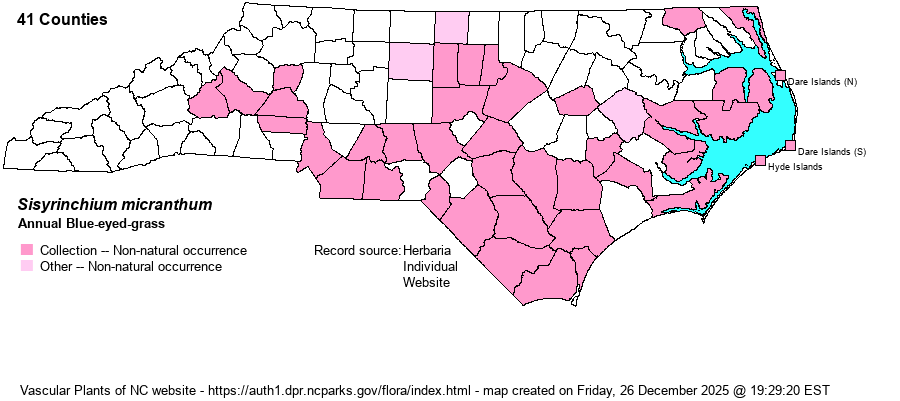| Author | Cav. | |
| Distribution | Found over the southeastern Coastal Plain, west to include the Sandhills and the southern Piedmont. Only a few records from the northern Coastal Plain and northern Piedmont. Many records (especially inland ones) have come since the 1990s, indicating recent spread. In 2023, a taxonomic revision has suggested that the species is not now considered as native not only in NC but in the U.S.
This is a Southern species ranging barely north to southeastern VA, and south to southern FL and eastern TX. It is native to Mex., Central America, and South America; widely naturalized elsewhere into the southeastern U.S. | |
| Abundance | Fairly common to locally common in the lower Coastal Plain from Currituck County to the SC border. Uncommon to locally fairly common in the southwestern Coastal Plain (including the Sandhills). Very rare in the Piedmont and northern Coastal Plain, but slowly increasing and spreading. | |
| Habitat | This is the only blue-eyed-grass that appears weedy and "exotic". It grows in lawns, vacant lots, roadsides, various sandy or mesic places in pine woods, and other sunny places often disturbed by man. | |
| Phenology | Blooms in April and May, and fruits in May and June. | |
| Identification | This is an odd Sisyrichium that differs quite a bit from all others in the state. The flowers tend to be white, pink, or very pale blue, a different color than most others. The 6 tepals tend to be triangular in shape rather than more rounded or parallel-sided in other species, giving the flower a more star-like shape. Most significantly, the tepals have a dark red to purple blaze mark at the base of each one; no other NC Sisyrinchium has any dark red on the tepals. This is an annual plant and can grow quickly. The stems often lean or grow at an angle or even prostrate, instead of straight up, and generally grows to only 6-8 inches tall. It has a cluster of narrow yet "wide" basal leaves, not as needle-like as many species. | |
| Taxonomic Comments | Formerly named as S. rosulatum, but the species has been lumped into S. micranthum in Weakley (2023), a species not considered as native to the U.S. (see Weakley's 2023 map). NOTE: An extremely similar species, S. minus Engelmann & Gray, occurs as near as AL. It differs mainly in its capsules which are taller than wide and which lack purple suture lines. A single fragmentary specimen from "waste places" on the DUKE campus (Durham County) in 1932 appears to be S. minus; however, we will not include it in BioDiv until more convincing material turns up.
| |
| Other Common Name(s) | Lawn Blue-eyed-grass, Fairy-stars | |
| State Rank | SE | |
| Global Rank | G5 | |
| State Status | | |
| US Status | | |
| USACE-agcp | | |
| USACE-emp | | |

